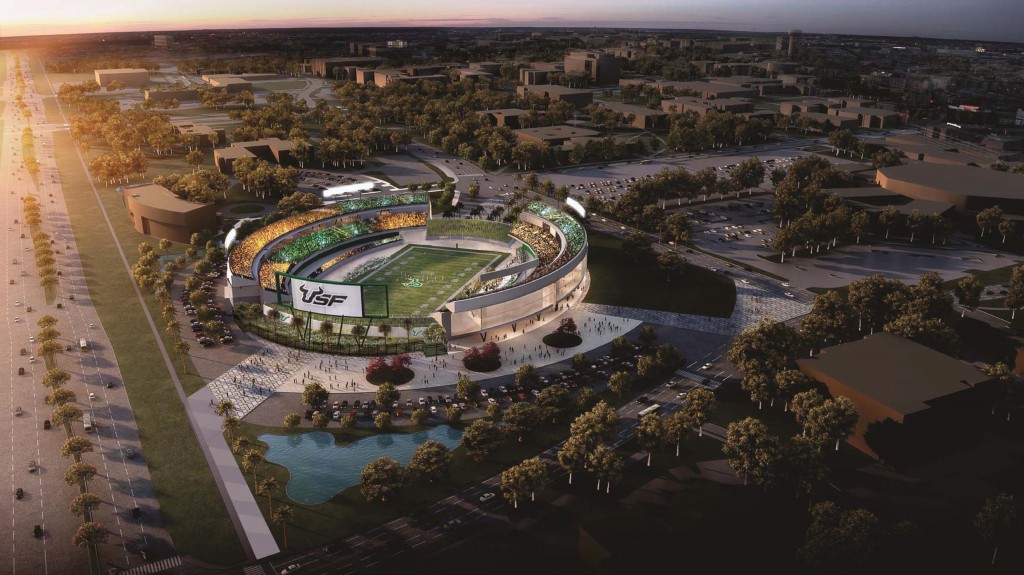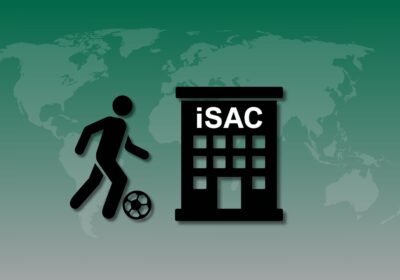Possible avenues for financing USF’s on-campus stadium

Plans to build an on-campus football stadium at USF are in motion, with 2026 positioned as an “aggressive” target for opening day. Before Bulls fans start planning tailgates by the Greek Village, however, the school has to nail down how the stadium will be paid for.
Recent examples around college football show a mix of corporate investment, student fees and government funding.
USF Athletics plans to present the Board of Trustees with an overall project budget scope at its next meeting on June 15, according to Vice President of Athletics Michael Kelly.
Construction cost estimates are expected to be between $250 million and $400 million, according to the Tampa Bay Times.
As of Sunday, the university has received commitments from longtime donors Frank and Carol Morsani as well as Jeff and Penny Vinik for a total of $10 million in private funding.
Even with the possibility of further donations, USF must find other ways of financing construction. One avenue most stadium projects have taken is securing investment through an exclusive naming rights agreement.
The most recent on-campus FBS stadium to open was at the University of South Alabama in 2020. The school announced a 10-year partnership with the Hancock Whitney Corporation in 2019 for naming rights to the 25,000-capacity venue, according to AL.com.
Although the terms of the deal weren’t officially disclosed, the university’s stadium investment opportunities webpage lists stadium naming rights at $10 million.
An official figure does exist at Colorado State University, which opened its own on-campus stadium in 2017. The university announced a 15-year, $37 million deal with Canvas Credit Union for naming rights in 2018 to help pay for the facility’s $220 million price tag.
For another example, USF can look within the AAC. Houston began playing football at TDECU Stadium in 2014 with a naming rights agreement with Texas Dow Employees Credit Union. The deal was for $15 million over 10 years, according to the Houston Chronicle.
A 2012 Houston student referendum showed overwhelming support for a $45 per-student, per-semester fee, the Associated Press reported. Over 9,000 students of a total student body of 40,746 participated in the vote, the largest turnout in school history.
Final approval from the UH Board of Regents was still necessary. A minutes summary of a March 2012 meeting detailed the stadium funding model and included a $24 million contribution labeled “Student Fee Bonds,” but didn’t specify a per-semester amount.
That number has curiously increased to $43.5 million as of Monday, according to Houston’s athletics department. The university also confirmed the $45 fee was launched in the fall of 2012 and will be in place for 25 years.
A similar student fee may be on the cards at USF, though that has yet to be confirmed. For what it’s worth, a 2018 student referendum for a $6-$9 per-credit-hour fee resulted in mixed reactions, according to records obtained by The Oracle.
Of the 1,753 USF students who participated, 48% voted against introducing such a fee. The margin of error was unknown by the time of publication. At the time, there was a population of 50,755 students, according to the 2018-19 USF System Facts.
In the event these methods don’t meet the estimated costs, USF may have to seek government funding in the form of tax-exempt bonds. These essentially function as low-interest loans and have to be paid back.
Some schools, like The Ohio State University, issued a bond to pay for the construction of athletic facilities and then charged their respective athletics departments rent for using them, according to ESPN. The payments were then used to chip away at the incurred debt.
USF can also look forward to saving a bit of cash once it finally departs Raymond James Stadium. Under its current agreement with Tampa Sports Authority (TSA), the university doesn’t pay rent but is charged license fees for the operation of the stadium each game day, according to the Tampa Bay Times.
In November 2021, TSA recorded just over $1 million in year-to-date revenue from college football license fees, according to documents from a December TSA Finance Committee meeting agenda.
This would account for the six USF football home games played in 2021. That’s another $1 million per year that could go toward the overall cost of an on-campus stadium. The university’s lease with Raymond James Stadium expires in 2027.
The ins and outs of the financial scope of constructing a state-of-the-art college football stadium are exhausting, but the likelihood is USF will have a more concrete plan this summer.
This story was updated.







